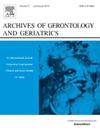Social determinants of health clusters and risk of cardiovascular disease among community-dwelling older men and women: A clustering and causal machine learning approach
IF 3.5
3区 医学
Q2 GERIATRICS & GERONTOLOGY
引用次数: 0
Abstract
Background
Social determinants of health (SDoH) significantly impact cardiovascular disease (CVD) risk. This study aims to identify SDoH clusters and explore their cumulative effects on CVD risk.
Methods
Data from the ASPirin in Reducing Events in the Elderly (ASPREE) trial, ASPREE eXTension study, and ASPREE Longitudinal Study of Older Persons (ALSOP) were used. The study participants were community-dwelling healthy individuals (5884 men and 7012 women) aged 70+ years. These participants were followed for 12 years (median: 8.4 years). The K-prototype algorithm to identify clusters of SDoH and the Cox model to evaluate the association between the SDoH clusters and CVD events were used. Causal Survival Forest was employed to explore the heterogenous treatment effect (HTE) of the SDoH clusters on CVD events.
Results
Two SDoH clusters, disadvantageous and advantageous, were identified. The advantageous group were more economically stable, socially active, and had positive neighbourhood factors. Being membership in the advantageous group was statistically significantly associated with a 31 % reduced risk of CVD events among women. By taking the disadvantageous SDoH group as the control group and the advantageous group as the treated group, there was indication of HTE on CVD among women; women who were in the treated group had delayed onset of CVD and the treatment could benefit specific groups, including smokers, individuals on antihypertensive medication, and older adults. However, among men there was no statistically significant association and HTE.
Conclusion
The study highlights the interconnectedness of SDoH and their greater impact on women's CVD risk compared to men.
社区老年男性和女性健康集群和心血管疾病风险的社会决定因素:聚类和因果机器学习方法
健康的社会决定因素(SDoH)显著影响心血管疾病(CVD)的风险。本研究旨在确定SDoH集群并探讨其对心血管疾病风险的累积影响。方法采用阿司匹林减少老年人事件(ASPREE)试验、ASPREE扩展研究和ASPREE老年人纵向研究(ALSOP)的数据。研究对象为70岁以上的健康社区居民(5884名男性和7012名女性)。这些参与者被随访了12年(中位数:8.4年)。使用K-prototype算法识别SDoH聚类,并使用Cox模型评估SDoH聚类与CVD事件之间的关联。采用因果生存森林(Causal Survival Forest)研究SDoH集群对CVD事件的异质性治疗效果(HTE)。结果鉴定出有利和不利两个SDoH集群。优势群体经济稳定、社会活跃、邻里因素积极。作为优势组的成员,在统计上与女性心血管疾病事件风险降低31%显著相关。以SDoH不利组为对照组,SDoH有利组为治疗组,观察HTE对女性心血管疾病的指征;治疗组的女性心血管疾病延迟发作,治疗可以使特定群体受益,包括吸烟者、服用抗高血压药物的个体和老年人。然而,在男性中,HTE与HTE没有统计学上的显著关联。结论该研究强调了SDoH的相互关联性,并且与男性相比,它们对女性心血管疾病风险的影响更大。
本文章由计算机程序翻译,如有差异,请以英文原文为准。
求助全文
约1分钟内获得全文
求助全文
来源期刊
CiteScore
7.30
自引率
5.00%
发文量
198
审稿时长
16 days
期刊介绍:
Archives of Gerontology and Geriatrics provides a medium for the publication of papers from the fields of experimental gerontology and clinical and social geriatrics. The principal aim of the journal is to facilitate the exchange of information between specialists in these three fields of gerontological research. Experimental papers dealing with the basic mechanisms of aging at molecular, cellular, tissue or organ levels will be published.
Clinical papers will be accepted if they provide sufficiently new information or are of fundamental importance for the knowledge of human aging. Purely descriptive clinical papers will be accepted only if the results permit further interpretation. Papers dealing with anti-aging pharmacological preparations in humans are welcome. Papers on the social aspects of geriatrics will be accepted if they are of general interest regarding the epidemiology of aging and the efficiency and working methods of the social organizations for the health care of the elderly.

 求助内容:
求助内容: 应助结果提醒方式:
应助结果提醒方式:


